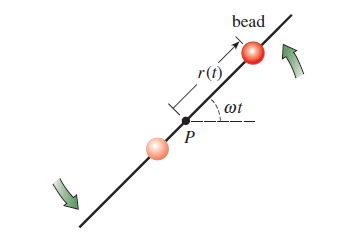A bead is constrained to slide along a frictionless rod of length L. The rod is rotating in a vertical plane with a constant angular velocity ω about a pivot P fixed at the midpoint of the rod, but the design of the pivot allows the bead to move along the entire length of the rod. Let r(t) denote the position of the bead relative to this rotating coordinate system, as shown in FIGURE 3.R.1. In order to apply Newton’s second law of motion to this rotating frame of reference it is necessary to use the fact that the net force acting on the bead is the sum of the real force
Problem
A bead is constrained to slide along a frictionless rod of length L. The rod is rotating in a vertical plane with a constant angular velocity ω about a pivot P fixed at the midpoint of the rod, but the design of the pivot allows the bead to move along the entire length of the rod. Let r(t) denote the position of the bead relative to this rotating
(a) Solve the foregoing DE subject to the initial conditions
(b) Determine initial conditions for which the bead exhibits simple harmonic motion. What is the minimum length L of the rod for which it can accommodate simple harmonic motion of the bead?
(c) For initial conditions other than those obtained in part (b), the bead must eventually fly off the rod. Explain using the solution r(t) in part (a).
(d) Suppose ω = 1 rad/s. Use a graphing utility to plot the graph of the solution r(t) for the initial conditions r(0) = 0, is 0, 10, 15, 16, 16.1, and 17.


Trending now
This is a popular solution!
Step by step
Solved in 3 steps with 3 images









